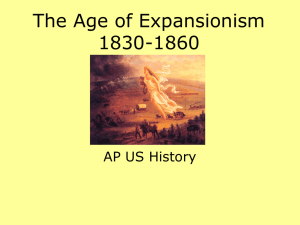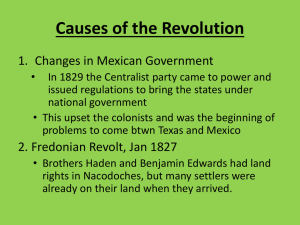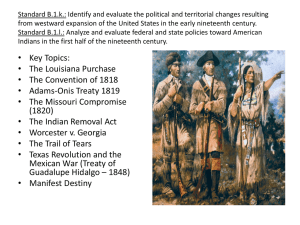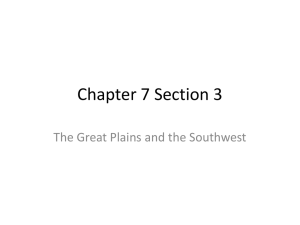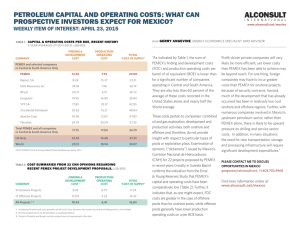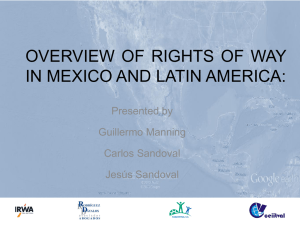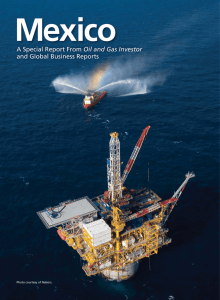Impact of Mexico Energy Reform_Final
advertisement
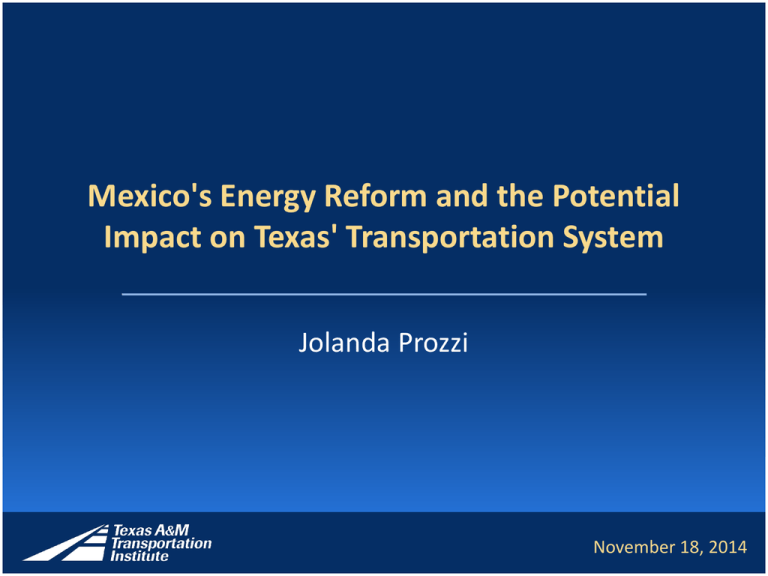
Mexico's Energy Reform and the Potential Impact on Texas' Transportation System Jolanda Prozzi November 18, 2014 Mexico’s Energy Sector • Reduced Mexican oil production since 2004 • Increased investment in exploration and extraction since 1997 • Increased imports of refined products and crude oil – Mexico to become a net oil importer • Government rely on revenues from Pemex Footer Text Mexico’s Energy Sector Source: Martinez, 2014 Mexico’s Energy Reform • Objectives – End Petróleos Mexicanos’ (PEMEX) monopoly – Encourage foreign investment in energy sector • Hand over regulatory authority of oil and gas sector: – Energy Regulatory Commission – Secretary of Energy – National Hydrocarbon Commission • Create new national agency of industrial safety and environmental protection Footer Text Mexico’s Energy Reform • Reserves available to PEMEX and foreign private companies? – PEMEX access to mature fields – Between 20% and 25% of onshore and offshore reserves for PEMEX • PEMEX lacks expertise with shale fields and deep water drilling • Private sector will be given more opportunities with shale fields and deep water drilling Exploration and Production Contracts • Oil and gas operator must be domiciled in and operate through a Mexican entity/subsidiary • Ministry of Energy – Select areas for bidding and establish technical and financial qualifications • Ministry of Finance – Establish economic and fiscal terms to E&P Contracts • National Hydrocarbons Commission – Organize and conduct E&P bid rounds • Operators will enter into competitive bidding process • Contract awarded to operator that will maximize Mexico’s revenues • E&P Round One preliminary blocks already announced – RFPs in February, 2015 Exploration and Production Contracts • Exploration Phase (4 to six years) – Studies to determine existence and location of hydrocarbons – Work program with geophysical/geological findings and intended drilling • Evaluation Phase (2 to 4 years) – Explore and evaluate a discovery (include road and drill site construction, drilling operations) – Determine wells are commercial – Determine viability of extracting hydrocarbons – Analyze social, environmental, and economic impact • Production Phase (20+ years) – Develop oil & gas fields (include transfer lines, transportation systems, and other oil & gas related transmission operations) Implementation Issues • Communal Land (ejidos) – 51% of Mexico’s surface is owned/controlled by ejidos • Security – Theft from PEMEX > $1 billion per year • Uncertainty – Oil deposits may only be located across from Eagle Pass – Less attractive dry and wet gas closer to Reynosa and Matamoros Source: Cañas, 2014 Burgos Basin and Texas’ Transportation System • Transportation supports three major activities in energy supply chain: – Well development – Resource production/extraction – Distribution Transportation and Well Development • Five-step well development process: – – – – – Site preparation Rigging up Drilling Hydraulic fracturing Rigging down Transportation and Well Development • Initial site preparation – Heavy bulldozers and dump trucks to build road to serve pad site • Move rotary rig to pad site and assemble on site – Require 35 to 45 semi-trucks and 50 to 75 people to assemble rig – Rigs and equipment will probably be moved from Texas – Short term increase in OS/OW loads on Texas transportation system and crossing Texas-Mexico border – Over long term, companies would invest in equipment • Drilling of the well hole – Requires steel pipe and cement - delivered on site by truck for casing and cementing the well hole – Mud for lubricating the drill delivered on site by truck – Mexico’s manufacturing capacity to produce steel oil field pipe and cement will determine impacts – Short term increase in pipe and cement from Texas manufacturing facilities Transportation and Well Development • Well hole economically viable; well is perforated and hydraulic fracturing begins: – Pumping air, water, chemicals, and sand or other “proppants” under high pressure into well hole – Frac sand originates from U.S. Midwest, Canada, and Brazil – In Texas: • Sand imported through port of Corpus Christi and trucked or railed to Eagle Ford Shale • UP developed “Sand 2 Shale” program to expedite sand delivery to Permian Basin and Eagle Ford • Oil and gas companies may use existing distribution networks to move sand into Mexico – Mexico will potentially meet water demands of hydraulic fracturing Transportation and Resource Production/Extraction • Disposal of salt water – Wells produce water (“flow back” water) – Typically trucked from well site to salt water disposal wells – No impact foreseen on Texas transportation system • Disposal wells tend to be local Transportation and Distribution • Only six refineries in Mexico and shortage of pipelines • Extracted oil shipped to refineries in Texas and Louisiana – From drill sites by truck to gathering hubs and terminals – From hubs and terminals by rail to refineries • U.S. rail systems facing challenges: – Increase in demand of rail car leases – New regulations on the safety of crude oil transportation • Another potential concern is the border crossings – Potential capacity issues • Pipelines required for natural gas development Concluding Remarks • Energy reforms and development of Burgos Basin can have significant impacts on Texas’ transportation system – Ports, rail, highways, and border crossings • Range from sending drilling equipment into Mexico to shipping oil from Mexico to Texas and Louisiana • Could generate substantial freight volumes, consisting of heavy oil field equipment and other materials (such as pipe, frac sand, and chemicals) from Texas into Mexico, as well as crude from Mexico to Texas Jolanda Prozzi j-prozzi@ttimail.tamu.edu (512) 584 9143

